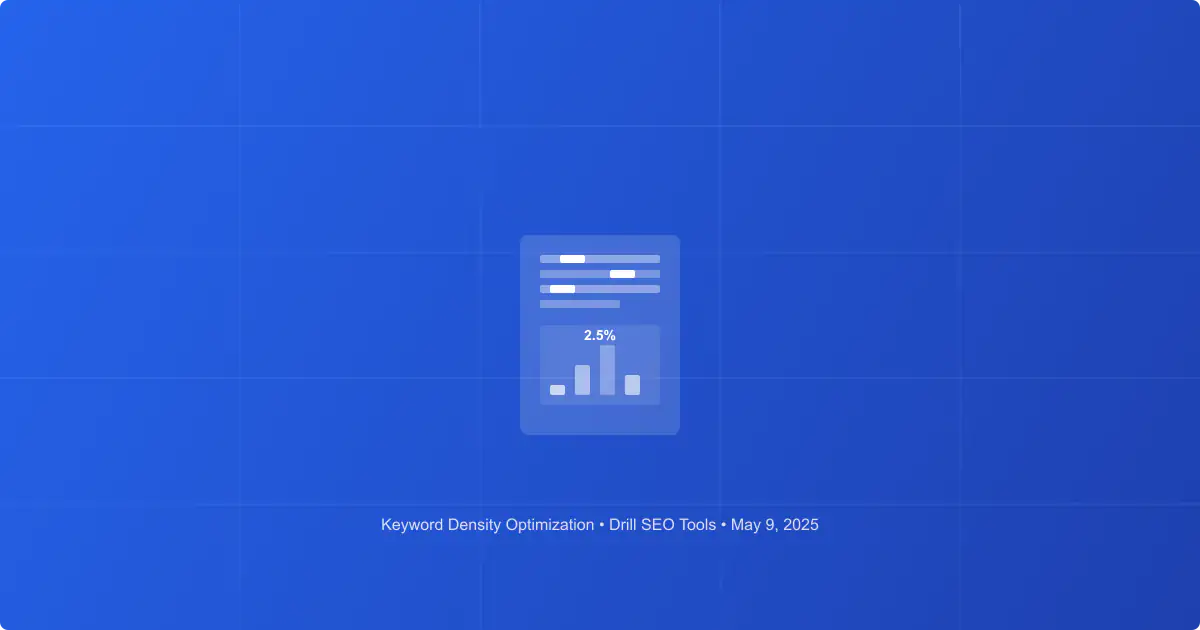Keyword Density Optimization: Finding the Perfect Balance for SEO
Learn how to optimize keyword density for better SEO performance without keyword stuffing. Discover best practices and tools for effective keyword usage.

Understanding Keyword Density in Modern SEO
Keyword density refers to the percentage of times a keyword or phrase appears on a webpage compared to the total number of words. While it remains an important aspect of SEO, its role has evolved significantly over the years.
In the early days of search engines, keyword density was a dominant ranking factor, leading to the practice of "keyword stuffing" - the excessive use of keywords in an attempt to manipulate rankings. Today, search engines like Google use sophisticated algorithms that prioritize content quality, relevance, and user experience over simple keyword metrics.
However, this doesn't mean keyword density is irrelevant. Using our Keyword Density tool can help you find the right balance for your content.
Why Keyword Density Still Matters
Despite the evolution of search algorithms, keyword density remains important for several reasons:
1. Topic Relevance Signals
Using relevant keywords helps search engines understand what your content is about. The strategic placement and natural frequency of keywords signal the topic and focus of your content.
2. User Experience
Appropriate keyword usage helps users find the information they're looking for. When users search for specific terms, they expect to find those terms in the content that addresses their queries.
3. Content Organization
Keywords help structure your content logically, making it easier for both search engines and users to navigate and understand your information.
Finding the Optimal Keyword Density
There's no universal "perfect" keyword density percentage that guarantees rankings. However, most SEO experts suggest these guidelines:
Primary Keywords
- Aim for a density of 1-2% for your primary keyword
- Include your primary keyword in the title, first paragraph, and conclusion
- Use it naturally throughout the content
Secondary Keywords
- Target 0.5-1% density for secondary keywords
- Distribute them evenly throughout your content
- Use variations and synonyms to avoid repetition
Our Keyword Density tool can help you analyze your content and ensure you're within these optimal ranges.
How to Use Our Keyword Density Tool
Step 1: Enter Your Content
Paste your content into our Keyword Density tool. You can analyze existing content or draft content before publishing.
Step 2: Analyze the Results
The tool will provide a comprehensive breakdown of:
- Overall word count (using our Word Counter technology)
- Single-word keyword frequencies and percentages
- Two-word phrase frequencies
- Three-word phrase frequencies
- Visual representation of keyword distribution
Step 3: Optimize Your Content
Based on the analysis:
- Adjust overused keywords to avoid keyword stuffing
- Add relevant keywords that are underrepresented
- Ensure natural keyword distribution throughout the content
- Use variations and synonyms for a more natural flow
Avoiding Keyword Stuffing
Keyword stuffing can lead to penalties from search engines and poor user experience. Signs of keyword stuffing include:
- Unnaturally high keyword density (typically above 3-4%)
- Keywords that don't flow naturally in sentences
- Repeated use of keywords in close proximity
- Hidden keywords (in metadata, alt tags, etc.) that don't relate to the content
Our Keyword Density tool helps you identify potential keyword stuffing issues before they become problems.
Keyword Optimization Beyond Density
While keyword density is important, modern SEO requires a more comprehensive approach:
1. Semantic Relevance
Use related terms and concepts that demonstrate topic expertise. Our Text Analyzer can help identify semantic relationships in your content.
2. Strategic Keyword Placement
Place keywords in important locations:
- Title tags and meta descriptions (create these with our Meta Generator)
- URL structure
- Heading tags (H1, H2, H3)
- First 100 words of content
- Image alt text
3. Content Quality and Depth
Focus on creating comprehensive, valuable content that naturally incorporates keywords. Use our Word Counter to ensure sufficient depth for your topic.
4. User Intent Alignment
Ensure your content addresses the search intent behind your target keywords. This often matters more than exact keyword density.
Integrating Keyword Density Analysis with Other SEO Tools
For a comprehensive SEO strategy, use our Keyword Density tool alongside these complementary tools:
- SEO Analyzer - For a complete website SEO audit
- Text Analyzer - To assess content readability and quality
- Word Counter - To ensure optimal content length
- Meta Generator - To create optimized meta tags
Conclusion
Keyword density remains an important aspect of SEO, but it's just one piece of the puzzle. The key is finding the right balance - using keywords strategically without compromising content quality or user experience.
Our Keyword Density tool helps you achieve this balance by providing detailed analysis and actionable insights. By combining this tool with our other SEO resources and following best practices, you can create content that ranks well and resonates with your audience.
Remember, the ultimate goal is to create valuable, relevant content for your users. When you do that while being mindful of keyword optimization, SEO success will follow.